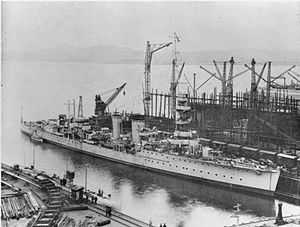HMS Caradoc (D60)
 | |
| Career | |
|---|---|
| Class and type: | C-class light cruiser |
| Name: | HMS Caradoc |
| Builder: | Scotts Shipbuilding and Engineering Company, Greenock |
| Laid down: | 21 February 1916 |
| Launched: | 23 December 1916 |
| Commissioned: | 15 June 1917 |
| Reclassified: | Became a base ship in April 1944 |
| Fate: | Sold to be broken up for scrap on 5 April 1946, scrapped May 1946 |
| General characteristics | |
| Tons burthen: | 4,190 tons |
| Length: | 450 ft (140 m) |
| Beam: | 43.6 ft (13.3 m) |
| Draught: | 14 ft (4.3 m) |
| Propulsion: | Two Brown-Curtis geared turbines Six Yarrow boilers Two propellers 40,000 shp |
| Speed: | 29 knots |
| Range: | carried 300 tons (950 tons maximum) of fuel oil |
| Complement: | 327 |
| Armament: | 5 × 6-inch (152.4 mm) Mk XII guns 2 × QF 3 inch 20 cwt AA guns |
| Armour: | 3 inch side (amidships) 2¼-1½ inch side (bows) 2 inch side (stern) 1 inch upper decks (amidships) 1 inch deck over rudder |
HMS Caradoc was a C-class light cruiser of the Royal Navy. She was part of the Caledon group of the C-class of cruisers.
Construction and early service
She was built by Scotts Shipbuilding and Engineering Company, Greenock. She was laid down on 21 February 1916, launched on 23 December 1916 and completed and commissioned into the Navy on 15 June 1917. She formed part of the 6th Light Cruiser Squadron of the Grand Fleet in common with the other ships of the Caledon subgroup. With her sister HMS Cassandra she ran aground on Fair Isle on 15 August 1917. Both ships were successfully salvaged.
Inter-war years
The Caradoc spent part of her time between the World Wars in the far east. In 1927 she was part of a Royal Navy flotilla involved in the Nanjing incident helping protect British and other foreign nationals and business interests.
Second World War
She was deployed into the Atlantic Ocean on the outbreak of war and assigned to operate off the North American coast. On 23 October 1939 the light cruiser HMS Orion and the Canadian destroyer HMCS Saguenay intercepted the German tanker Emmy Friedrich. When the Caradoc arrived on the scene, the Germans scuttled their ship to prevent her capture. On 11 December 1940 the German blockade runner Rhein was intercepted by the Dutch sloop HNLMS Van Kinsbergen west of the Florida Strait. The Rhein was set on fire by her own crew to prevent her capture, and the wreck was sunk later that day by HMS Caradoc.
Caradoc became a base ship in April 1944, and after the end of the war was considered obsolete. She was sold to be broken up for scrap on 5 April 1946 and subsequently scrapped at Briton Ferry, Wales in May 1946.
References
- Colledge, J. J.; Warlow, Ben (2006) [1969]. Ships of the Royal Navy: The Complete Record of all Fighting Ships of the Royal Navy (Rev. ed.). London: Chatham Publishing. ISBN 978-1-86176-281-8. OCLC 67375475.
- Jane's Fighting Ships of World War One (1919), Jane's Publishing Company
- HMS Caradoc at Uboat.net
- Ships of the Caledon class
| ||||||||||||||||||||||||||||||||||